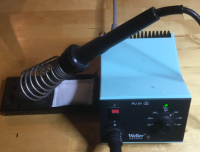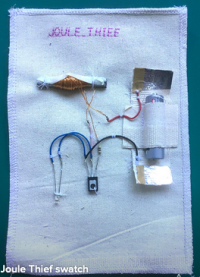Difference between revisions of "Energy for Designers"
| Line 74: | Line 74: | ||
==Week 1 - Day 2== | ==Week 1 - Day 2== | ||
Technical day: | Technical day: | ||
| + | |||
| + | You have to know 2 laws | ||
| + | Ohms law V = I * R | ||
| + | Power law P = V * I | ||
| + | The laws seem to be simple, but the combinations, in series and in parallel for example make life a bit more complicated. | ||
Basic electronics, Soldering | Basic electronics, Soldering | ||
Revision as of 21:39, 25 January 2019
Energy for Designers intro
Energy is one of the big challenges of our society to be solved by you as an inventor designer. We will be trying out weird ways to generate and harvest energy, like algae, chocolate, dance floor, mud, a Joule Thief, body heat and ice. We will also compare this to energy made with a potato, a solar cell, a wind turbine. Or just hack and be an energy parasite! With this experience, you will experiment further and connect your source of energy to your design idea. This can be a product, fashion, or a drawing, illustration, a knitting, architecture or a poster.
What is energy?
Cappuccino Energy 47 kcal = 197 kJ (per 100 ml) 12 minutes vacuum cleaning Smart phone battery: 47.5 kJ = 10 kcal
Big energy for heating houses, cities.
Small energy for your own gadgets and hacks and smart textiles, or charging your smart phones.
Nano energy, from plants, algae, bacteria.
Week 1 - Day 1
The link to the ppt will be provided soon (if this wiki wants to eat my file...)
A dutch windmill in action [1]
How the people in the Middle Ages managed to lift stones to make cathedrals
My toy steam engine is running on a blower [2]
Potato power
Getting energy out of ice and my hand - energy harvesting with a Peltier element [3]
Solar cells of course.
Hand crank devices
Plant power (indicating a voltage and a current, but there is no "power")...

Some current |

Some voltage |
Discussion: We also talked about this question: What is more interesting for a designer... Something that works or something that maybe (not) works For example, a solar cell (works) or a plant (who knows if it works)
Week 1 - Day 2
Technical day:
You have to know 2 laws Ohms law V = I * R Power law P = V * I The laws seem to be simple, but the combinations, in series and in parallel for example make life a bit more complicated.
Basic electronics, Soldering
Basic calculations, numbers
Batteries, 3V, 1.5V, power of a battery
Lipo, power cells
Joule Thief experiments - boosting voltage
Potato battery
Mud Algae, plant - cell battery
Bike dynamo set up
Hand charging devices IKEA made
Solar cell examples IKEA

Soldering, ppt: |

We made a Joule Thief, boosting device, ppt: |

|

https://makezine.com/projects/power-paper-circuits-with-static-electricity/ https://makezine.com/2013/10/10/new-technology-paper-generators-harvest-static-electricity/
|
Week 1 - Day 3
Starting your own assignment considerations
Making the paper generator
Finishing the Joule Thief
Week 1 - Day 4
Working on your own
Week 1 - Day 5
Working on your own
Week 2 - Day 1
Tutoring
Intro microcontrollers
Adding sensors to a microcontroller
Week 2 - Day 2
Working on your own
Week 2 - Day 3
Tutoring
Week 2 - Day 4
Working on your own
Finishing, testing
Week 2 - Day 5
Presentation day!



